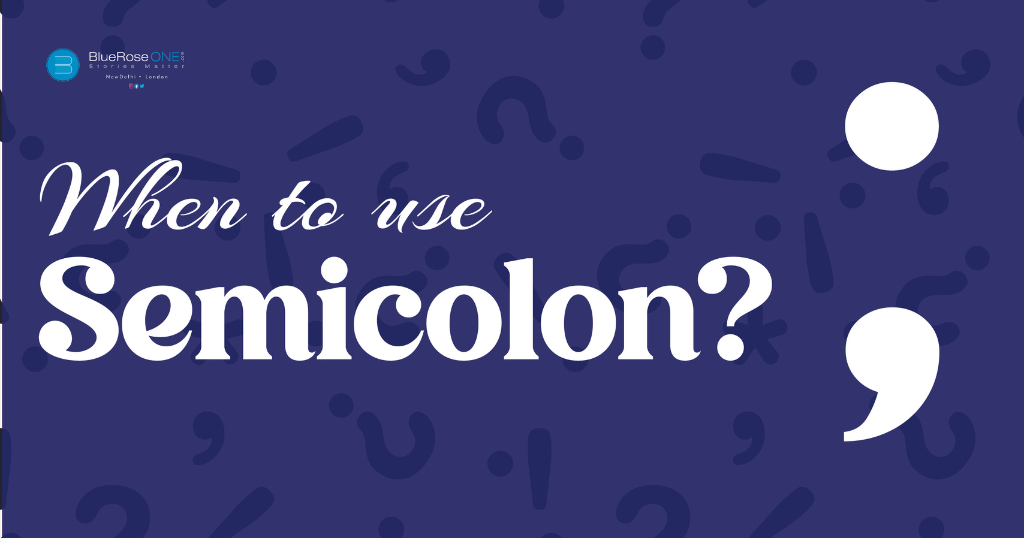Semicolons can be a source of confusion for many writers. They occupy a middle ground between commas and periods, offering a unique way to connect and separate clauses in a sentence. Understanding when and how to use semicolons is essential for improving your writing’s clarity and style. In this comprehensive guide, we’ll explore the rules governing semicolon usage, provide examples, and answer frequently asked questions. By the end, you’ll be equipped with the knowledge and confidence to use semicolons effectively in your writing.
Read: How to do Character Development: Bringing Your Characters to Life
The Basics: What Is a Semicolon?
A semicolon is a punctuation mark that serves two primary functions:
- To connect closely related independent clauses.
- To separate items in a list when those items contain internal commas.
Let’s delve into each of these functions to gain a deeper understanding of semicolon usage.
1. Connecting Independent Clauses
One of the most common uses of semicolons is to connect closely related independent clauses—clauses that could stand alone as separate sentences but are linked in meaning. Here’s the basic rule: you can use a semicolon to join two independent clauses that are closely related in thought, creating a smoother and more concise sentence structure.
Examples:
- I love to write; it’s a form of creative expression.
- She excels at mathematics, and her problem-solving skills are exceptional.
- The sun was setting, and the sky turned a beautiful shade of pink
2. Separating Items in a List with Internal Commas
Semicolons are also useful when you have a list of items, and some of those items contain internal commas. In such cases, semicolons are used to clearly separate the items and avoid confusion.
You may also like: How to Publish a Book? | Publish a Book | BlueRoseOne
Examples:
- The conference will be attended by writers from New York, New York; Los Angeles, California; and Chicago, Illinois.
- The ingredients for the recipe include flour, sugar, and eggs; butter, salt, and milk; and chocolate chips.
Using Semicolons: Rules and Examples
The semicolon is a frequently misunderstood punctuation mark. While many writers are comfortable with the basics, such as separating independent clauses or items in a list, the nuances of semicolon usage can be more challenging. In this guide, we will delve into the intricacies of semicolon usage, providing you with a thorough understanding of when and how to use this versatile punctuation mark.
Part 1: Joining Independent Clauses
Semicolons can be employed to join two closely related independent clauses. When using a semicolon in this manner, it is crucial to ensure that the clauses are of roughly equal importance and relate to the same topic. Semicolons work well when you want to demonstrate a stronger connection between two sentences than a period would provide, without relying on conjunctions like “and” or “but.” Let’s look at an example:
Example: “The rain began to fall; I ran for cover.”
In this sentence, the semicolon is used to connect two independent clauses. The first clause, “The rain began to fall,” and the second clause, “I ran for cover,” are closely related. Using a semicolon here emphasises the connection between these two actions, indicating that seeking shelter is a direct response to the rain.
Semicolons are an excellent choice when you want to highlight the relationship between independent clauses without using coordinating conjunctions like “and,” “but,” “for,” “so,” or “yet.” They offer a middle ground between the firm separation of a period and the closeness of a conjunction.
Part 2: Separating Items in a List with Internal Commas
Another important use of semicolons is to separate items in a list when the items themselves contain internal commas. This is particularly valuable when you want to maintain clarity and distinguish between individual list elements. Let’s examine an example:
Example: “The authors include Jane Austen, ‘Pride and Prejudice’; F. Scott Fitzgerald, ‘The Great Gatsby’; and George Orwell, ‘1984’.”
In this instance, semicolons are used to clearly separate the authors and their respective works, each of which contains a comma within the title. This usage prevents any potential confusion that could arise from the internal commas in the list elements.
Part 3: Three Common Situations to Use a Semicolon
Now, let’s delve deeper into three common situations in which you should use a semicolon in your writing.
Situation 1: Connecting Closely Related Ideas
One of the most valuable uses of a semicolon is to connect two closely related ideas. This occurs when you wish to emphasise the relationship between two independent clauses without resorting to coordinating conjunctions like “and,” “but,” “for,” “so,” or “yet.” Consider the following example:
Example: “The moon rose over the horizon; the night was clear and serene.”
In this case, the semicolon serves to convey the strong connection between the moon rising and the clear, serene night. The absence of a conjunction adds a sense of continuity and coherence to the narrative. It’s as if the two clauses are intimately linked, allowing the reader to appreciate the beauty of the night as it unfolds.
You may also like: What is a Preface? Key Characteristics with Examples
Situation 2: Separating List Items with Internal Commas
As mentioned earlier, semicolons are invaluable when separating items in a list that themselves contain internal commas. This practice aids in avoiding confusion and clearly demarcating the separation between list elements. Let’s explore this in greater detail:
Example: “We need to visit the following cities on our road trip: New York, New York; Los Angeles, California; and Chicago, Illinois.”
In this instance, the semicolons play a crucial role in distinguishing the cities listed for the road trip. The internal commas within the city names could potentially create ambiguity if not for the semicolons. By using semicolons, we ensure that each city is distinct and easily identifiable, contributing to the overall clarity of the sentence.
Situation 3: In Place of a Conjunction
Semicolons can also replace conjunctions like “and” or “but” to join two closely related independent clauses. This technique helps vary your sentence structure and creates a smoother flow in your writing. Let’s take a look at an example:
Example: “She had a passion for art; he preferred literature.”
In this case, the semicolon replaces the conjunction “and,” resulting in a more concise and connected sentence. The use of a semicolon here adds a touch of sophistication to the writing, giving it a distinct rhythm and flow.
When Not to Use a Semicolon
While semicolons have their place in writing, there are situations where it’s best to avoid using them:
- Connecting unrelated clauses: Semicolons are intended to join closely related clauses. If two clauses aren’t logically connected, using a semicolon may confuse your readers. In such cases, opt for a period or another form of punctuation.
Incorrect: “The sun was shining; my cat is named Whiskers.” - Overusing semicolons: Like any punctuation mark, overusing semicolons can disrupt the flow of your writing and make it harder to read. Use them sparingly and only when they enhance clarity and style.
- Using semicolons in fiction dialogue: In fiction writing, semicolons are rarely used in dialogue. Readers are more accustomed to seeing characters’ speech separated by commas, periods, or question marks.
You may also read: Quilbot Review: Can It Really Improve Your Writing in Literature?
How Do You Use a Colon Correctly?
Colons (:) are another form of punctuation that writers often confuse with semicolons. While semicolons connect closely related independent clauses, colons have their own distinct function.
Use a colon to:
- Introduce a list or series: Colons are often used before a list or series of items, providing a clear separation between the introductory clause and the list.
Example:
“We need to buy the following groceries: milk, eggs, and bread.” - Introduce an explanation, elaboration, or quotation: Colons can be used to introduce explanations or elaborations, as well as quotations.
Example:
“Her reason was simple: she wanted to pursue her dreams.” - Separate hours and minutes in time notation: In time notation, colons are used to separate hours and minutes.
Example:
“The meeting is scheduled for 3:30 PM.”
What Is a Simple Semicolon Sentence?
A simple semicolon sentence is a sentence that consists of two independent clauses joined by a semicolon. This type of sentence structure is often used to emphasise a close connection between the two ideas presented in the clauses.
Example:
“The sun was setting; the sky turned a beautiful shade of pink.”
In this simple semicolon sentence, the first clause (“The sun was setting”) and the second clause (“the sky turned a beautiful shade of pink”) are closely related, and the semicolon serves to highlight this connection.
Read: How to Overcome Writer’s Block: 10 Proven Ways to Unlock Your Creativity
Semicolons are valuable punctuation marks that provide clarity and style to your writing. By understanding when and how to use semicolons, you can enhance the flow and coherence of your sentences, creating a more engaging reading experience for your audience. Whether connecting closely related ideas or separating complex list items, semicolons are a versatile tool in the writer’s toolbox. Practice and integrate these rules, and soon, you’ll be using semicolons with confidence and precision in your writing.
Frequently Asked Questions:
- To connect closely related independent clauses.
- To separate items in a list when those items contain internal commas.
- In place of a conjunction, join two closely related independent clauses.
- When connecting unrelated clauses.
- When overusing semicolons.
- In fiction dialogue, other punctuation marks are more appropriate.
















